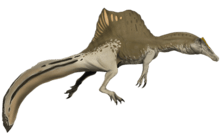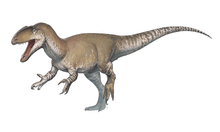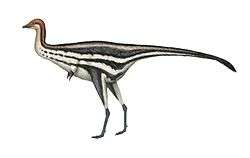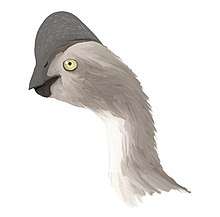Aepyornithomimus
Aepyornithomimus (meaning "Aepyornis mimic") is a genus of ornithomimid theropod dinosaur from the Late Cretaceous Djadokhta Formation in Mongolia. It lived in the Campanian, around 80 million years ago, when the area is thought to have been a desert. The type and only species is A. tugrikinensis.[1]
| Aepyornithomimus | |
|---|---|
 | |
| Holotype metatarsals | |
| Scientific classification | |
| Kingdom: | Animalia |
| Phylum: | Chordata |
| Clade: | Dinosauria |
| Clade: | Saurischia |
| Clade: | Theropoda |
| Clade: | †Ornithomimosauria |
| Family: | †Ornithomimidae |
| Genus: | †Aepyornithomimus Tsogtbaatar et al., 2017 |
| Type species | |
| †Aepyornithomimus tugrikinensis Tsogtbaatar et al., 2017 | |
Phylogeny

In a phylogenetic analysis, Aepyornithomimus was found to be a derived ornithomimosaur, closely related to Struthiomimus, Ornithomimus, Gallimimus, and Anserimimus. The exact systematics within this group of derived ornithomimids could not be resolved, but they were found to be closely related to the Deinocheiridae and Archaeornithomimus (which grouped with an unnamed taxon from the Bissekty Formation). Morphologically, observations were made that it seemed transitional between the metatarsal condition in basal ornithomimosaurs and more derived ones, and it was suggested that A. tugikinensis shows an intermediate condition.[1]
Paleoecology
The Djadokhta Formation where Aepyornithomimus was found was an arid eolian desert similar to the modern Gobi Desert. Later in the Campanian age and into the Maastrichtian the climate would shift to the more humid fluvial environment seen in the Nemegt Formation. A. tugrikinensis is the first diagnostic ornithomimosaur found in these earlier, drier deposits, and indicates the group could tolerate a variety of environmental conditions.[1]
References
- Tsogtbaatar, C.; Kobayashi, Y.; Khishigjav, T.; Currie, P.J.; Watabe, M.; Rinchen, B. (2017). "First Ornithomimid (Theropoda, Ornithomimosauria) from the Upper Cretaceous Djadokhta Formation of Tögrögiin Shiree, Mongolia". Scientific Reports. 7: Article number 5835. doi:10.1038/s41598-017-05272-6. PMC 5517598. PMID 28724887.














